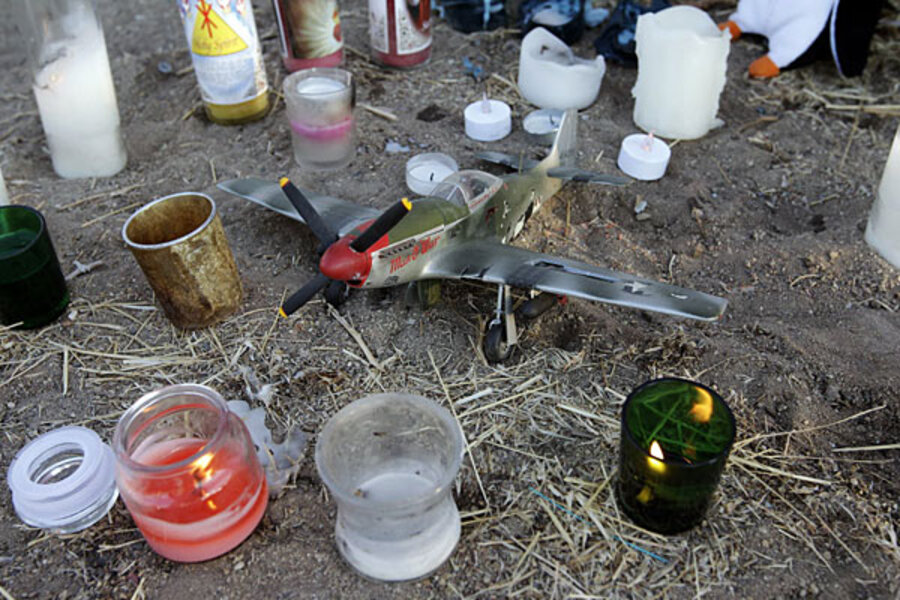Reno air crash: Will tragedy at air race sour public on air shows?
Loading...
| Los Angeles
The crash of a World War II-era plane last Friday that killed 10 people and injured dozens more at the Reno Air Races in Nevada will undoubtedly lead to a review of safety regulations and may give longstanding critics of the Reno event the ammunition they need to press for its cancellation.
But pending the outcome of the investigation into the tragic crash of the P-51 Mustang – the National Transportation Safety Board and the Federal Aviation Administration say initial results will be released this Friday – air show officials are expressing concerns that an anxious public not lump their industry in with the higher risk air races.
Although both events developed as an outgrowth of barnstorming – the popular form of entertainment in the 1920s in which stunt pilots would captivate small towns by landing in corn fields and then create live shows on the spot – air racing and air shows are very different and should be understood as such, says John Cudahy, president of the International Council of Air Shows (ICAS).
Both became wildly popular before World War II but the air race business has shrunk – the Reno event is the only unlimited class (i.e. vintage planes) air race event in the US, he says – while air shows continue to grow.
Air racing involves competition between pilots racing vintage airplanes up to 500 mph, whereas air shows are choreographed entertainment in which the same stunts – barrel rolls, inverted loops, wing walking etc. – are repeated performance after performance.
While the Reno Gazette has editorialized that spectators need to be better educated about the risks of air racing, Mr. Cudahy says the safety rules for air shows have been a top priority since the formation of his group in 1964. Although both have evolved over the years, he says air shows have very specific rules governing how close the planes can fly to spectators.
Cudahy cautioned against reaching any conclusions about the Reno tragedy until officials have completed their investigations. He said the safety record of air shows was a perfect, zero deaths in 2008, 2009, and 2010 before this year’s string of six deaths – three pilots and three wing walkers.
“Frankly, that three-year string of no deaths as well as this year’s string of six are both statistical anomalies,” he says. Although the industry was extremely proud of the three-year total, he said, it did not let up on its mission of maintaining and improving safety wherever possible, which it does by examining the history of mishaps and then designing rules to avoid them in the future.
Regarding the P-51 Mustang aircraft that crashed into the spectator area in Reno, Cudahy says air show rules would have completely avoided such a mishap because of a number of restrictions, among them:
• Air craft are not allowed to point toward crowds, “so in the event of a slipup, aircraft won’t plunge into spectators.”
• Air shows have setbacks ranging from 500 ft. for smaller propeller planes to 1,500 ft. for jets and include an “invisible box” – no fly zone – as long as 2 miles long, half mile wide and 12,000 ft. high above grandstands.
• Those who fly acrobatically must be evaluated by both the ICAS and the FAA at least once every year.
Villanova University sociology professor Rick Eckstein, who specializes in sports and society, applauds the rules that have evolved in air shows and says the ideas go beyond just the safety of the events to the long-term economic protection of the industry itself.
Fred George, senior editor at Aviation Week, says the investigations of this crash may eventually lead to cancellation of the Reno event, or at least a move to less populated areas. Another modification could include placing the grandstands in the center of the race track rather than where they were Friday coming out of the race’s most dangerous and final curve, so that when a plane goes out of control, centrifugal force carries it outward and away from, rather than into, the spectators.
“There are a lot of people who have been trying to get rid of this event for years. They will be trying to seize this as their opportunity to get that done,” he says.
Short of that, the venue could be placed further out in the desert, perhaps closer to Black Rock where the “Burning Man” festival is held.
Mr. George says inspection procedures are likely to get an overhaul as well.
“It’s one thing to quickly inspect the fuselage and wings, but quite another to really examine the moving parts that control the plane,” George says. “That takes more time and focus. These planes are modified so much that pilots are pretty much test pilots on every flight.”





